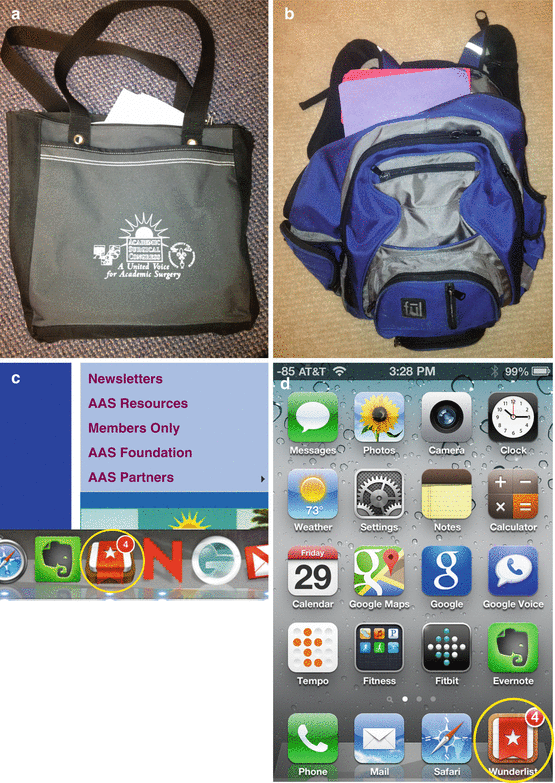Fig. 3.1
The authors’ ((a) HC, (b) AG) weekly calendars. Each week is structured to minimize context switching between the clinical and research realms
Structure Your Clinic
As you can see (Fig. 3.1), both authors have their clinic day and OR day back-to-back. This minimizes context switching between clinical and lab. Both of the authors have clinic on a Tuesday afternoon. This is a subtle point designed to maximize patient and family satisfaction. The key here is to try to avoid having your clinic on Mondays or Fridays – these are most often impacted by holidays. Additionally, having an afternoon clinic allows it to run late without interfering with activities later in the day (e.g., scheduled meetings).
Pile on the Clinical Work on Clinical Days
Seek out and embrace clinical work on your clinical days. Round on your inpatients between cases. Structure your call schedule such that your OR day is the day you take call as well – add any urgent cases on to the end of your scheduled day. If cases add up and push late into the evening, that is ok. This is the day that you should negotiate in advance with your loved ones (spouse, kids, pet, cactus) that it is ok for you to miss dinner. Additionally, if your practice permits, do not feel bad about handing over the cases that you do not finish before your partner comes on call the next day. (As a corollary, do not give them grief when they leave cases for you on your clinical day).
Limit Scheduled Meetings
Part of your faculty responsibilities will likely include participation in meetings and committees. In your first few years of faculty appointment, attempt to minimize your obligations to these sorts of activities. When you must participate, limit the times you are available and the length of the meetings. Include in your weekly schedule 2–3 h per week in which your administrative assistant can schedule meetings without your approval (Fig. 3.1). Try to limit the meetings to 30 min or less. Also, try not to schedule meetings that do not have a set agenda – this will minimize wasted time. If a meeting must take place at a time outside of your “scheduled meeting” block (e.g., with your chairperson), make sure your administrative assistant requires your explicit approval to schedule it. Finally, if meetings must take place on your research days, limit them to the early morning or evening hours, minimizing context switching in the middle of the day.
Structuring Your Research Days
These are the most important days for your scientific success. The advice here is simple: completely avoid clinical and service activities. These days should consist of experiments, data analysis, reading, thinking, and writing. Below, we will discuss strategies for planning your scientific output over the first year of your faculty appointment.
Lab Meeting
There are many approaches to running a lab meeting, and they vary based on the size of the lab and the personality of the principal investigator. A general recommendation is to hold a lab meeting near the beginning of the week. This allows the lab members to act on the results of the meeting and generate data over the course of the week. It also allows the weekend for data preparation for presentation.
To-Do Lists
An Internet search for “time management” will yield approximately two billion results: there are myriad tools and systems geared towards helping us manage our time effectively. While detailed reviews of specific software products are beyond the scope of this chapter, we will provide some insight into tips and tricks that have been effective for the authors.
Have a Clinical Task Bag
On your operating day, rather than sitting in the operating room lounge watching CNN between cases, use all of the downtime to be more productive. The authors both have a bag that they carry to the clinic and operating room (Fig. 3.2a). Think of this bag as a mobile in-box/out-box. This bag has manuscripts to review, notes for letters to dictate, charts to sign, letters of recommendation to write, student reports to grade, etc. Ideally these will be items that can be completed in 5–15 min. Of note, this is not the place to keep the manuscripts you are working on related to your laboratory effort – this bag should be limited to the clinical context. Your assistant should be able to add to and remove from this bag as needed. On research days this bag sits on/under the desk and receives no attention until the next clinical day.


Fig. 3.2
(a) Clinical task bag. This bag contains manuscripts to review, notes for letters to dictate, charts to sign, letters of recommendation to write, student reports to grade, etc. and accompanies the author to the operating room and clinic. (b) Research task bag. This bag contains recent journal(s) to read, review articles, trainee drafts of manuscripts to edit, etc. and accompanies the author on all nonclinical days. (c, d) Screenshots showing context-specific to-do lists that are synced between smartphone and computer desktop
Carry a Research Task Bag
This is the bag that contains your research context (Fig. 3.2b). This bag should accompany you everywhere you go outside the hospital (e.g., barbershop/hairdresser, oil changes). Recent journal(s) to read, review articles, and trainee drafts of manuscripts to edit are the types of things to find in this bag. Carrying this bag with you is another way in which you can maintain the research context throughout the week.
Stay updated, free articles. Join our Telegram channel

Full access? Get Clinical Tree


